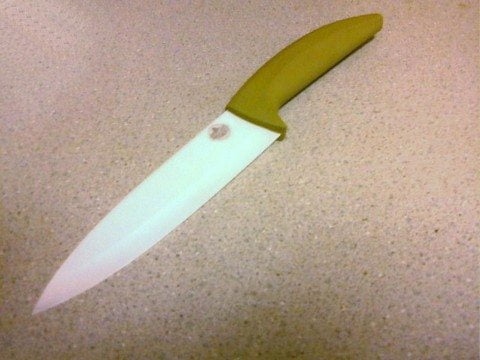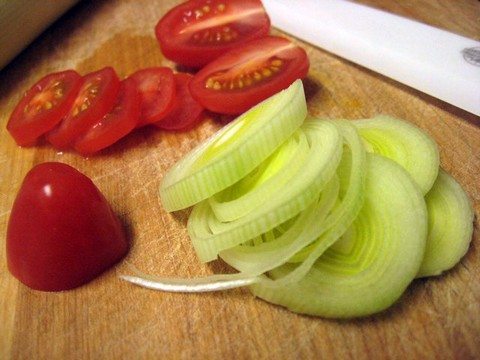One of the most essential tools in any cook’s kitchen is a good knife – and I mean a really good knife. For years I have used 2 Global knives, which I love and were a pretty little investment. That is the problem with knives, quality rises with price. The newest advances in knives, too, these days are ceramic knives…which also come at a steep price.
Well I was recently given an opportunity to try out any item of my choice (to a certain extent) at CNS Stores and review it. They had a ceramic knife that fit within that budget. I had to try it!
Meet my new knife: the Wade Ceramics American Masala Utility Knife in Green/White. This model is a utility knife which is made of a white ceramic blade with a green handle. The blade measures 5 inches long. One of the things that hits you right a way when you pick up this knife is its weight. It barely weights anything and is super comfortable grip wise. A ceramic utility knife is ideal for slicing, mincing and cutting through boneless meat, vegetables and fruits.
Ok so I hear you asking me why would one want a ceramic knife versus a metal one. Here are some advantages:
– a ceramic knife is a knife made out of very hard ceramic, often zirconium oxide. Zirconia is very hard; it ranks 8.5 on the Mohs scale of mineral hardness, compared to 6 to 6.5 for hardened steel, and 10 for diamond, giving a very hard edge that rarely needs sharpening. Ceramic blades can only be resharpened with a material harder than themselves; industrial grade diamond sharpeners are usually used.
– the blade will never rust; they are often used by scuba divers.
– the blade will not absorb the taste or odor of cut food as the ceramic is not very porous.
– Same reason, they are very easy to clean. A quick rinse in warm water will get your ceramic knife a lot cleaner than a thorough scrubbing on a metal knife. It is recommended to hand wash ceramic knives instead of putting them in the dishwasher.
Still, a few precautions…
Since they are very brittle they cannot be used for chopping, cutting bones or frozen foods or for any application which tends to twist the blade such as prying, which may cause the cutting edge to chip or the blade to break free from the handle. The blade could break if dropped or seriously knocked around.
How does it perform? Like BUTTAH. I am terribly impressed. First thing I cut was a zucchini and papaya. I barely put any pressure on the handle and it slid right through the fleshes. Then I tried a tomato. It makes a really clean cut on the skin and lets you cut thinner whole slices. Through meat it was divine as well. Basically, it just requires a lot less arm power for beautiful cuts. I really love this ceramic knife.






Great point, having a great knife is essential in the kitchen. Having a great knife is pretty essential in a lot of situations/professions, really.
Try to cut the thinnest slice of tomato possible. I’ll be impressed if you can do it with the ceramic knife.
I think Laurent secretly wants to marry the knife too, so… He’d be jealous, but not in the sense one might think! 😉
I am very particular of my choice of knives. This appears to be a very good one…after all…it did pass the tomato test ;o)
Ciao for now, Claudia
All of my knives are ceramic except my cleaver of course. I have all the kyocera knives and they are amazing.
Cheers
Euh…Valérie…I Laurent aware of this change in relationship if the knife proposes lol?
I couldn’t agree more: I was given a ceramic knife a while ago, and I love it! I would marry it!